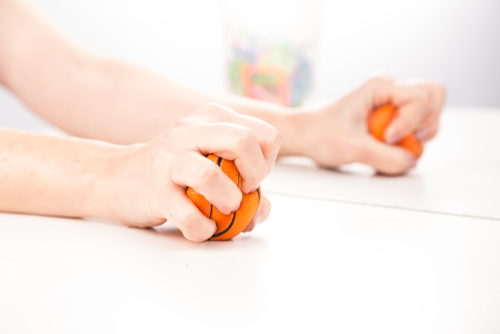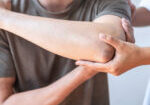Mirror therapy has many implications for therapy and can be used to treat many diagnoses that commonly involve the upper extremity. These include some of the Neuro Conditions we highlighted last week including, Stroke and Focal Hand Dystonia. Btw, you can download a mirror therapy exercises pdf here for free.

How long should the patient perform mirror therapy exercises? Should there be a sequence of routines prior to performing mirror therapy? There is no simple answer and a wide range of dosing information along with frequency and duration for performing mirror box therapy.
Despite the variety in rehab regimes for mirror therapy, the majority of them have demonstrated positive effects. From the studies, a general protocol was developed know as the St. Gallen MT Protocol. The St. Gallen MT Protocol was tested on 52 patients. Of those, 42 out of 52 patients showed a reduction in pain, improved function, and no phantom sensations.
Here are some key highlights from the studies and the St. Gallen MT Protocol.
Keys to using mirror therapy in treatment
- Explain clearly how mirror therapy works, the patient must have the buy-in
- Perform mirror therapy in a quiet environment
- Set up a home program using mirror therapy (mirror therapy boxes) can be made out of cardboard boxes by gluing a handheld mirror on the side or you can fabricate a wooden one for under $15 (see below video below).
- Utilize a patient log for tracking mirror therapy exercises.
- Review patient log at follow-up therapy visits
Duration
- Home Program must be performed 5-6x/day,
- Each session should be no longer than 5-10 minutes
- Adapt exercise based on diagnosis
Grunert-Pluss, N., Hugschmid, U., & Santschi, L. (2008). Mirror therapy in hand rehabilitation: A review of the literature, the st gallen protocol for mirror therapy and evaluation of a case series of 52 patients, 13, 1, 4-11.
Supply list for making a mirror box (mirror therapy handout)
https://www.handtherapyacademy.com/wp-content/uploads/2019/06/mirror-box-material-list-.pdf
Video on how to make a mirror box
2 Comments
Leave a Comment
More To Read
When should you use a Static Progressive Splint in Hand Therapy?
Flowers, K. (2002). A proposed decision hierarchy for splinting the stiff joint, with an emphasis on force application parameters. Journal of Hand Therapy, 15, 158–162. The Skinny- The article proposes a decision hierarchy to determine when you should apply a static progressive or dynamic orthosis. The decision hierarchy uses a modified Weeks test (MWT). The…
Read MoreEffects of different stretching techniques for improving joint range of motion.
Reference: Oba, K., Samukawa, M., Abe, Y., Suzuki, Y., Komatsuzaki, M., Kasahara, S., Ishida, T., & Tohyama, H. (2021). Effects of Intermittent and Continuous Static Stretching on Range of Motion and Musculotendinous Viscoelastic Properties Based on a Duration-Matched Protocol. International journal of environmental research and public health, 18(20), 10632. https://doi-org.libproxy.nau.edu/10.3390/ijerph182010632 The Skinny: This study used a cross-over…
Read MoreThumbs up for treating thumb pain in the hand therapy clinic
What do “Mommy’s thumb,” “gamer’s thumb,” and “radial styloid tenosynovitis” have in common? They are all officially called de Quervain’s tenosynovitis De Quervain’s involves the tendons within the first dorsal compartment, abductor pollicis longus (APL) and extensor pollicis brevis (EPB) and arises when the tendons are inflamed and are not able to move through the…
Read MoreTennis Elbow and Graded Exercises
Lateral Elbow Pain with Graded Exercise Chronic tennis elbow with a supervised graded exercise protocol Özdinçler, A. R., Baktır, Z. S., Mutlu, E. K., & Koçyiğit, A. (2023). Chronic lateral elbow tendinopathy with a supervised graded exercise protocol. Journal of Hand Therapy, 36(4), 913–922. https://doi.org/10.1016/j.jht.2022.11.005 The Skinny: This study looked at the effectiveness of an…
Read MoreSign-up to Get Updates Straight to Your Inbox!
Sign up with us and we will send you regular blog posts on everything hand therapy, notices every time we upload new videos and tutorials, along with handout, protocols, and other useful information.







I need help creating a similar box but the one I want has the mirror inside glued to box and has a 3 inch opening in the top wood above the mirror so you need to be standing up looking through opening to view the mirror and see your hand writing on paper (which of course will be reversed and challenging to even print your name.) I had one years ago and used it for children and Adults to learn about Dyslexia. Hoping you can help!
Sounds like a fun project. good luck and let us know how it turns out.